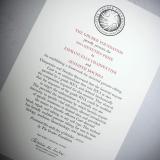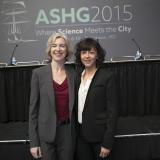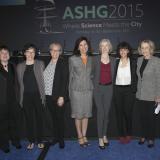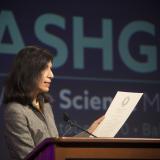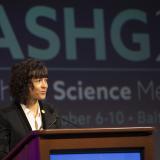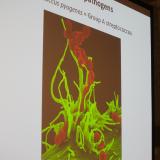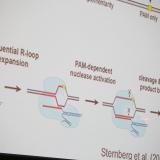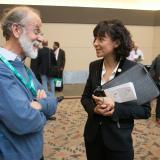2015 Gruber Genetics Prize
Microbiologist Emmanuelle Charpentier, PhD, of the Helmholtz Centre for Infection Research in Germany and of Umeå University in Sweden and biochemist Jennifer Doudna, PhD, of the University of California, Berkeley, revolutionized the field of molecular genetics with their 2012 joint discovery of gene-editing technology known as CRISPR/Cas9, which functions as a molecular scissor, cutting and destroying targeted DNA strands with exceptional precision. The technology is being used around the world to advance biological research and to engineer genes for developing powerful new therapies for a wide range of human diseases, as well as new biofuels and agricultural products.
2015 Genetics Prize Recipients
Laureate Profile
The trans-Atlantic scientific collaboration of Emmanuelle Charpentier, PhD, of Umeå University in Sweden, and Jennifer Doudna, PhD, of the University of California, Berkeley, began in 2011 when they met at a scientific conference in Puerto Rico. They had been independently investigating the molecular mysteries of CRISPR systems, an unusual repeating sequence of DNA that enables bacteria to mount a successful defense against viral invaders. Doudna, a biochemist and structural biologist, had been studying CRISPR-Cas protein RNA complexes that protect bacteria from viral infection. Charpentier, a bacteriologist, geneticist and biochemist, was focusing on another type of CRISPR-Cas, the type II CRISPR-Cas system known as CRISPR-Cas9, had recently identified the critical role that trans-acting CRISPR RNA (tracrRNA) performs in processing of the CRISPR-mediated virus defense in the type II CRISPR-Cas system now known as the CRISPR-Cas9 system in a seminal paper published in Nature in 2011.
The following year, in a landmark 2012 paper in Science, Charpentier and Doudna showed exactly how the protein Cas9 “reads” genetic information on CRISPR sequences using its guiding RNA and uses that information to seek out and destroy the invading viral DNA, essentially by cutting it up. The two scientists also demonstrated that this cellular defense system had applications behind killing viruses, for the RNA could be engineered to attach to any spot on the genome, thus encouraging the Cas9 protein to cleave that spot. That made the CRISPR system an exceptionally powerful tool, for it could be customized to delete or add specific strands of DNA. The finding has revolutionized the field of molecular biology and genetics.
Watch Videos
Citation
The Gruber Foundation proudly presents the 2015 Genetics Prize to Emmanuelle Charpentier and Jennifer Doudna for establishing a framework for universal genome editing.
Charpentier and Doudna discovered that the bacterial enzyme Cas9 is an endonuclease that cuts DNA at sites specified by a guide RNA, and defined biochemically the components required for this reaction. They showed that the sequence of the guide RNA could be modified to target the endonuclease to virtually any site. This provided the mechanism by which bacteria acquire immunity to specific viral infections, allowed introduction of specific mutations at desired sites, and provided the means to transfer efficient Cas9-directed break, repair, and editing to any cell type. This method has broadly enabled genome editing for uses in basic biology, medicine, biotechnology, and agriculture.




